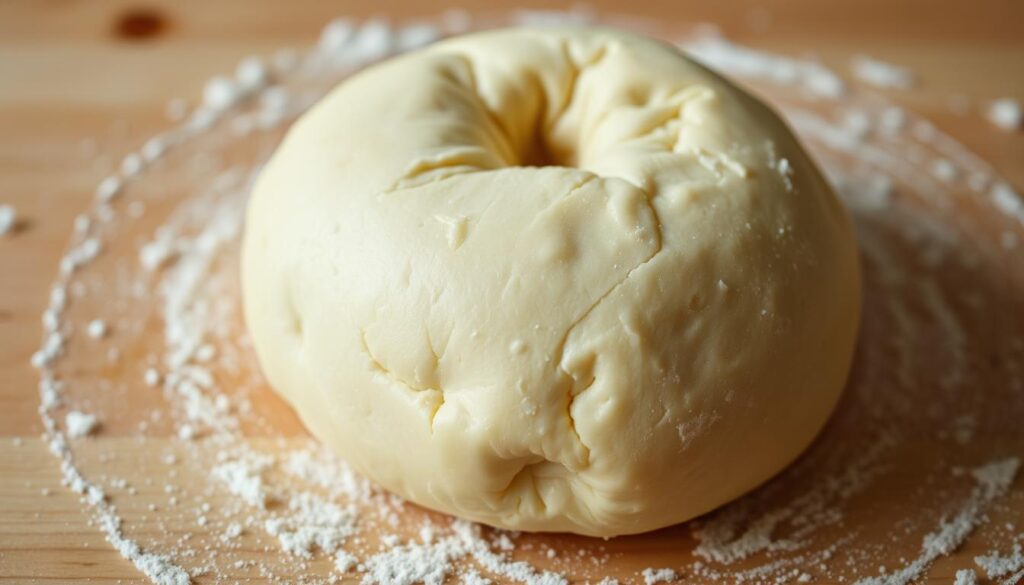Delicious Ingredient Greek-Yogurt Bagels at Home
Welcome to the world of homemade bagel making! Creating delicious bagels at home is easier than you think, especially with the addition of Greek yogurt as a key ingredient. This simple twist not only enhances the flavor but also boosts the nutritional value of your homemade bagels.
Using Greek yogurt in your bagel dough introduces a tangy flavor and tender crumb, making your homemade bagels a delight to eat. Plus, it’s a great way to incorporate healthy bagel ingredients into your diet. With a few simple ingredients and a straightforward process, you can enjoy freshly baked, wholesome bagels right in the comfort of your own home.
Key Takeaways
- Easy to make homemade bagels with Greek yogurt
- Healthier bagel option with added nutritional benefits
- Simple ingredients and straightforward process
- Customizable with your favorite toppings and flavors
- Perfect for a healthy breakfast or snack
The Magic of Homemade Bagels
There’s something special about biting into a freshly baked bagel made in the comfort of your own kitchen. Making bagels at home is not just about baking; it’s about crafting a personal culinary experience that can be tailored to your taste preferences and dietary needs.
Why Make Bagels at Home
Making bagels at home gives you control over the ingredients, allowing you to avoid preservatives and additives found in store-bought bagels. With homemade bagels, you can choose the quality and type of flour, the amount of sugar, and even the type of salt used. This control is particularly beneficial for those with dietary restrictions or preferences.
Additionally, baking bagels at home can be a fun and rewarding experience, especially when shared with family or friends. The process of mixing, kneading, and shaping the dough can be therapeutic and provides an opportunity to be creative with different flavors and toppings.
The Greek Yogurt Advantage
Incorporating Greek yogurt into your bagel recipe enhances the nutritional profile and taste. Greek yogurt adds moisture and tenderness to the bagels, making them softer and more delicious. The yogurt bagel benefits include a higher protein content and a tangy flavor that complements a variety of toppings, from classic cream cheese to more adventurous spreads.
| Benefit | Description |
|---|---|
| Higher Protein Content | Greek yogurt increases the protein content of the bagels, making them more satisfying. |
| Improved Texture | The moisture from the yogurt results in a softer, more tender crumb. |
| Enhanced Flavor | The tanginess of Greek yogurt adds a unique flavor dimension to the bagels. |
What Are Ingredient Greek-Yogurt Bagels?
The incorporation of Greek yogurt in bagel recipes has revolutionized traditional baking. Greek yogurt bagels are a type of bagel that uses Greek yogurt as a primary ingredient, enhancing both the texture and nutritional profile of the final product.
So, what makes Greek yogurt so special in baking? Let’s dive into the details.
The Science Behind Greek Yogurt in Baking
Greek yogurt contains acidity that reacts with baking soda, creating a lighter and airier texture in bagels. This reaction is crucial for achieving the perfect chewiness. The proteins in Greek yogurt also contribute to a more tender crumb.
The benefits of using Greek yogurt in bagel dough include:
- Enhanced texture through acid-baking soda reaction
- Increased protein content for a more satisfying bagel
- A moist and tender crumb
Nutritional Profile and Benefits
Greek yogurt bagels offer several nutritional benefits. They are higher in protein and lower in calories compared to traditional bagels. The use of Greek yogurt also adds calcium, which is essential for bone health.
Some key nutritional advantages include:
- Higher protein content for better satiety
- Lower calorie count
- Rich in calcium for bone health
Essential Ingredients for Perfect Bagels
Creating the perfect Greek-Yogurt Bagel starts with understanding the essential ingredients that make it delicious and nutritious. The quality of your bagels depends heavily on the ingredients you choose, so let’s dive into the key components.
Choosing the Right Greek Yogurt
Greek yogurt is a crucial ingredient in our bagel recipe, providing moisture, tanginess, and a boost of protein. When selecting Greek yogurt, opt for a high-quality, full-fat version for the best flavor and texture. Non-fat or low-fat versions can result in a denser bagel.
Flour Selection and Alternatives
The type of flour you use can significantly impact the texture and taste of your bagels. Traditional bagel recipes often call for high-gluten flour, but you can experiment with alternatives like whole wheat or ancient grain flours for added nutrition and flavor. Here’s a comparison of different flour types:
| Flour Type | Protein Content | Flavor Profile |
|---|---|---|
| High-Gluten Flour | High | Neutral |
| Whole Wheat Flour | Medium | Nuttier |
| Ancient Grain Flour | Variable | Complex, slightly sweet |
Additional Key Components
Besides Greek yogurt and flour, other essential ingredients include leavening agents, sweeteners, and salt. These components work together to give your bagels the right rise, flavor, and texture.
Leavening Agents
Active dry yeast is commonly used as a leavening agent in bagel recipes. It ferments the sugars in the dough, producing carbon dioxide and giving the bagels their characteristic chew.
Sweeteners and Salt
A small amount of sugar or honey can help activate the yeast, while salt enhances the flavor and controls yeast growth. The balance between sweet and salty is crucial for a well-rounded taste.
By carefully selecting and balancing these ingredients, you can create delicious and healthy Greek-Yogurt Bagels that are perfect for any meal.
Kitchen Equipment You’ll Need
Before you start baking delicious Greek-Yogurt Bagels, it’s crucial to have the right kitchen equipment. Having the proper tools not only makes the process easier but also ensures that your bagels turn out perfectly. In this section, we’ll explore the essential tools you’ll need to get started.
Basic Tools for Beginners
For those new to bagel baking, there are a few basic tools that are indispensable. These include a large mixing bowl, a measuring cup, a wooden spoon or silicone spatula, and a baking sheet lined with parchment paper. A digital scale is also highly recommended for accurate ingredient measurement, which is crucial for achieving the right dough consistency.
Optional Specialized Equipment
While not necessary for beginners, some specialized equipment can enhance your bagel baking experience. A stand mixer with a dough hook attachment can significantly reduce the effort required to mix and knead the dough. A bagel proofing basket or a banneton can help achieve a more uniform shape and texture. Additionally, a baking stone or a baking steel can improve the crust’s crispiness.
Step-by-Step Recipe for Basic Greek-Yogurt Bagels
Making Greek-Yogurt Bagels at home is a straightforward process that yields delicious results. With a few simple ingredients and some basic kitchen equipment, you can create perfect bagels every time.
Mixing and Preparing the Dough
Start by combining 1 cup of Greek yogurt, 2 cups of flour, 1 teaspoon of salt, and 1 tablespoon of sugar in a large mixing bowl. Mix the ingredients until they form a sticky dough. Knead the dough on a floured surface for about 10 minutes until it becomes smooth and elastic. Place the dough in a greased bowl, cover it with a damp cloth, and let it rest for 1 hour.
Shaping Techniques for Perfect Bagels
Divide the dough into 4-6 equal pieces, depending on the size of bagel you prefer. Roll each piece into a ball and then use your thumbs to create a hole in the center, stretching it out to form a bagel shape. Place the shaped bagels onto a baking sheet lined with parchment paper, leaving about 1 inch of space between each bagel.
Baking Times and Temperatures
Preheat your oven to 375°F (190°C). Place the bagels on the middle rack and bake for 20-25 minutes, or until they’re golden brown. Here’s a quick reference table for baking times and temperatures:
| Oven Temperature | Baking Time |
|---|---|
| 375°F (190°C) | 20-25 minutes |
| 400°F (200°C) | 15-20 minutes |
Keep an eye on your bagels during the baking time, as oven temperatures can vary.
Troubleshooting Common Bagel Problems
Troubleshooting is a crucial step in mastering the art of homemade bagel baking. Even with the best recipe, issues can arise that affect the final product. Understanding how to address these problems is key to achieving perfect bagels every time.
Dough Consistency Issues
One of the most common problems encountered when making bagels is achieving the right dough consistency. If the dough is too sticky, it can be difficult to shape; if it’s too dry, the bagels may turn out dense. To fix sticky dough, gradually add small amounts of flour until you reach the desired consistency. Conversely, if the dough is too dry, a small amount of water can help. It’s also important to ensure your ingredients are at room temperature, as this can affect how they come together.

Baking and Texture Challenges
Baking issues can also impact the final texture of your bagels. Overbaking can lead to bagels that are too crispy or hard, while underbaking can result in a soft, doughy interior. To avoid these issues, keep a close eye on your bagels during the baking process. Using a baking stone can help achieve a more even bake, as it distributes heat more efficiently. Additionally, ensuring your oven is at the correct temperature is crucial, as an off temperature can significantly affect baking results.
By addressing these common issues, you can improve your bagel baking skills and enjoy delicious homemade bagels. Whether it’s adjusting your dough or fine-tuning your baking technique, troubleshooting is an essential part of the baking process.
Delicious Topping Ideas for Your Bagels
With your freshly baked bagels, the possibilities for delicious toppings are endless. The beauty of homemade bagels lies in their versatility, allowing you to experiment with a wide range of flavors and ingredients to suit your taste preferences.
Traditional Bagel Toppings
Classic bagel toppings never go out of style. Cream cheese is a timeless favorite, offering a rich and tangy complement to the dense, chewy texture of bagels. You can also opt for smoked salmon, capers, and thinly sliced red onion for a more savory experience. For a simpler yet satisfying option, try pairing your bagel with butter or avocado.
Creative Flavor Combinations
For those looking to venture beyond traditional toppings, there are countless creative flavor combinations to explore. Consider topping your bagel with hummus and sliced cucumber for a refreshing twist, or layer on some roasted vegetables like bell peppers and zucchini for added depth of flavor. The key is to experiment and find the perfect balance that suits your palate.
Sweet Options for Breakfast Bagels
Bagels can also be a delightful breakfast option when topped with sweet ingredients. Try spreading some jam or honey on your bagel for a sweet start to the day. You can also add sliced bananas or berries for extra flavor and nutrition. For a more indulgent treat, consider topping your bagel with cream cheese frosting and sprinkling some cinnamon on top.
Flavor Variations for Ingredient Greek-Yogurt Bagels
Discover the numerous flavor variations you can create with Greek yogurt bagels, from savory to sweet options that cater to different tastes and dietary preferences.
Savory Bagel Variations
Savory Greek yogurt bagels offer a delicious twist on traditional flavors. You can enhance your bagels with various ingredients to create mouth-watering savory options.
Herb and Cheese Options
Incorporating herbs like rosemary or thyme, and cheeses such as feta or parmesan, can add rich flavors to your bagels. These combinations are perfect for those who enjoy a savory start to their day.
Spicy and Umami Flavors
For those who prefer a bit of spice, adding chili flakes or jalapeños can give your bagels a spicy kick. Umami flavors from ingredients like garlic or sun-dried tomatoes can also elevate the taste.
Sweet Bagel Variations
On the sweeter side, Greek yogurt bagels can be transformed into delightful treats by incorporating fruits, berries, or dessert-inspired flavors.
Fruit and Berry Additions
Mixing in dried fruits like cranberries or cherries, or fresh berries, can create a sweet and satisfying flavor profile. These bagels are perfect for breakfast or as a snack.
Dessert-Inspired Bagels
Imagine bagels flavored like cinnamon rolls or chocolate chip cookies. By adding cinnamon, sugar, or cocoa powder, you can create dessert-inspired bagels that are sure to please.
| Flavor Variation | Main Ingredients | Taste Profile |
|---|---|---|
| Savory Herb | Rosemary, Olive Oil | Herbaceous, Savory |
| Spicy | Jalapeño, Cheddar | Spicy, Rich |
| Fruit & Berry | Cranberries, Orange Zest | Sweet, Fruity |
| Dessert-Inspired | Cinnamon, Sugar | Sweet, Cinnamon-Spiced |
Storing and Freezing Your Homemade Bagels
The key to enjoying your homemade bagels over time lies in how you store them after baking. Proper storage ensures that your bagels remain fresh and delicious for as long as possible.
Short-Term Storage Methods
For short-term storage, you can keep your bagels at room temperature or in the refrigerator. At room temperature, store them in a paper bag or a breathable container to maintain freshness for up to 2 days. If you prefer to refrigerate, place the bagels in an airtight container to keep them fresh for up to 5 days.
| Storage Method | Duration | Container Type |
|---|---|---|
| Room Temperature | Up to 2 days | Paper bag or breathable container |
| Refrigeration | Up to 5 days | Airtight container |
Freezing, Thawing, and Reheating Techniques
For longer storage, freezing is an excellent option. To freeze your bagels, first, let them cool completely. Then, place them in a single layer on a baking sheet and put it in the freezer until they are frozen solid. Transfer the frozen bagels to a freezer-safe bag or airtight container. To thaw, simply leave them at room temperature or reheat them directly from frozen in a toaster or oven.

Reheating Tips: For a crispy crust, reheat your thawed bagels in the oven at 375°F (190°C) for about 5 minutes. Alternatively, you can toast them for a quick snack.
Serving Suggestions and Perfect Pairings
Homemade Greek yogurt bagels are incredibly versatile, making them perfect for any meal of the day. Whether you’re looking for a quick breakfast on-the-go or a satisfying lunch, these bagels can be tailored to suit your needs.
Breakfast and Brunch Ideas
Start your day with a nutritious breakfast by topping your bagel with scrambled eggs, avocado, and a sprinkle of salt and pepper. For a sweeter option, try pairing your bagel with cream cheese and fresh berries.
Lunch and Sandwich Combinations
For a satisfying lunch, consider turning your bagel into a sandwich with smoked salmon, cream cheese, and thinly sliced red onion. Alternatively, a classic combination of turkey breast, lettuce, tomato, and mayonnaise on a toasted bagel makes for a quick and easy meal.
Complementary Spreads and Fillings
Enhance your bagel experience with a variety of spreads and fillings. Hummus adds a rich, creamy texture, while almond butter provides a nutty flavor. For a tangy twist, try using a Greek yogurt-based spread with honey or fruit preserves.
Experimenting with different combinations will help you discover your favorite ways to enjoy your homemade Greek yogurt bagels.
Health Benefits of Homemade Greek-Yogurt Bagels
Making bagels at home with Greek yogurt allows for a healthier alternative to store-bought options. By controlling the ingredients, you can ensure that your bagels are made with wholesome, nutritious components.
Nutritional Comparison to Store-Bought Options
Homemade Greek-Yogurt Bagels have a distinct nutritional profile compared to their store-bought counterparts. The use of Greek yogurt adds protein and reduces the need for additional sugars or fats. Let’s compare the nutritional values:
| Nutritional Component | Homemade Greek-Yogurt Bagel | Store-Bought Bagel |
|---|---|---|
| Calories | 150 | 250 |
| Protein | 10g | 5g |
| Sugar | 2g | 5g |
Dietary Adaptations for Special Needs
One of the significant advantages of making bagels at home is the ability to adapt the recipe to special dietary needs. Whether you’re looking for gluten-free, lower-carb, or protein-rich versions, homemade bagels can be tailored to suit your requirements.
Gluten-Free Modifications
To make gluten-free Greek-Yogurt Bagels, you can substitute traditional flour with a gluten-free flour blend. This modification allows individuals with gluten intolerance to enjoy bagels without compromising on taste or texture.
Lower-Carb and Protein-Rich Versions
For a lower-carb version, reduce the amount of flour used and add almond flour or another low-carb alternative. To boost the protein content, you can add protein powder or extra Greek yogurt to the dough.
Conclusion
With the comprehensive guide provided, you’re now well-equipped to create delicious homemade bagels using a Greek yogurt bagel recipe. The journey to perfecting your bagel-making skills is not only fun but also rewarding, allowing you to enjoy healthier and tastier bagels right from your kitchen.
By incorporating Greek yogurt into your bagel dough, you’re not only enhancing the nutritional profile but also improving the texture, making your homemade bagels a delight to bite into. Experiment with various toppings and flavor variations to keep your bagel game exciting and tailored to your preferences.
As you continue to bake and experiment with different Greek yogurt bagel recipe variations, you’ll find that making homemade bagels becomes an integral part of your baking routine. So, get baking and enjoy the satisfaction of creating delicious, healthy treats that are sure to impress family and friends alike.







